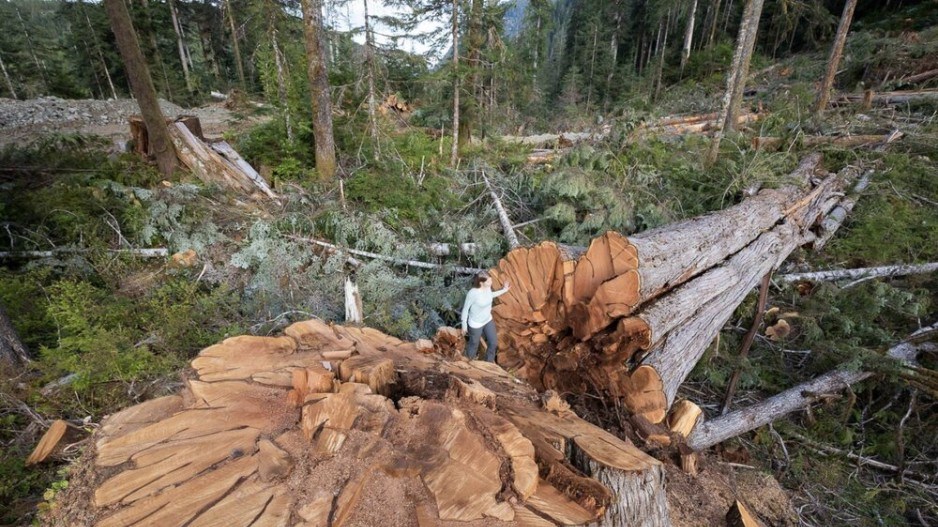Satellite surveillance shows 31,800 hectares of old-growth trees — 50 per cent more than the government reported — have been logged in the three and a half years since the province promised a “paradigm change” in B.C. forestry practices.
That’s according to a recent report from the environmental group Stand.earth, which used a satellite watchdog platform to track old-growth logging since April 2020. That month marked the release of the Old Growth Strategic Review, a landmark report that signalled government might put an end to cutting the rarest old-growth stands.
The satellite tracking system, known as Forest Eye, was built with the help of the satellite firm Planet Labs. It systematically tracks forest cover change across the province since the B.C. government promised to halt logging in big treed old-growth forests nearly three years ago. The group said it manually verifies all the alerts the system flags to ensure forest cover loss occurred due to logging activity.
Tegan Hansen, senior forest campaigner for the group, said in a statement the numbers were “shocking.”
“The grim reality is that the province could provide this data to the public if they wanted to. And so far they have not,” said Hansen. “It’s going more quickly than the province can keep track of.”
A spokesperson for the Ministry of Forests said it is working on improving real-time data collection but that “it does not support the claims in the report.”
The satellite analysis “appears to conflate” old-growth forests logged before deferrals were proposed with those that came after, said the spokesperson in an email.
“These areas were not identified by the [Old Growth Technical Advisory Panel] when logging occurred and should not be counted as candidate deferrals,” he said.
Satellite imaging shows logging before and after government reporting, says group
Old-growth deferrals are meant to halt logging and remain in place until long-term plans to overhaul forestry practices can take effect. The province says it seeks to reorient the industry to prioritize the health of forest ecosystems and long-term resilience of communities in line with recommendations from a 2020 Old Growth Strategic Review.
The Ministry of Forests says about 11,600 hectares of old growth flagged for protection were logged between November 2021 and February 2023 — about 0.5 per cent of what has been protected — according to a February 2023 government press release. That amount had climbed to roughly 19,960 hectares by June 30, 2023, said a spokesperson for the ministry.
The Stand.earth analysis says that figure climbs to an estimated 31,800 hectares if you count the nearly year-and-a-half run-up after the release of the Old Growth Strategic Review.
Hansen said the logging revealed by their satellite tracking system suggests one of two things: either the province “underestimated” how much logging is happening in at-risk old-growth forests, or they are hiding what they already know.
The incomplete picture of what old growth has been logged is slowly being filled in, she said — sometimes when the environmental group's researchers learn how the government is directing logging permits on the ground, and at other times, as the satellite detects new losses in forest cover.
“We’re still working on alerts we’ve gotten in the last couple of weeks,” Hansen said.
Data does not support report's claims, says government
In an email, a spokesperson for the Ministry of Forests pushed back against claims it was backsliding on its commitments to protect old-growth forests, and that its “data does not support the claim that old growth logging was at any point fast-tracked.”
“It typically takes 1-2 years to get a Cutting Permit issued, so the ability to fast-track does not exist,” said the spokesperson.
Logged old-growth flagged for deferral was less than one per cent of the 2.6 million hectares recommended by the Old Growth Strategic Review's Technical Advisory Panel (TAP), said a statement attributed to the ministry.
To date, the ministry said it has protected 1.23 million hectares of old-growth forest the TAP flagged for deferral. It said it continues to negotiate with First Nations — including "many" who support the deferrals, "some" who want to defer other old-growth outside the identified areas, and "others" who want to continue logging on their territory.
“We welcome the opportunity to discuss current data with Stand.earth,” said the spokesperson.
Editor's Note: This story has been updated with a response from the Ministry of Forests




